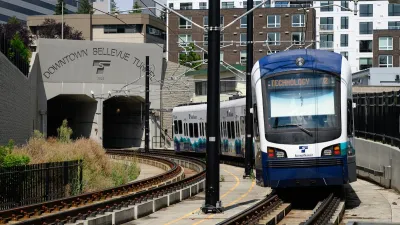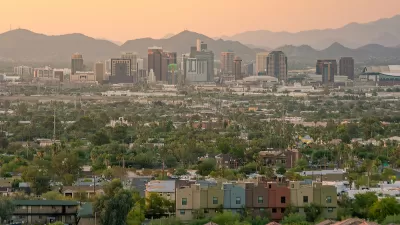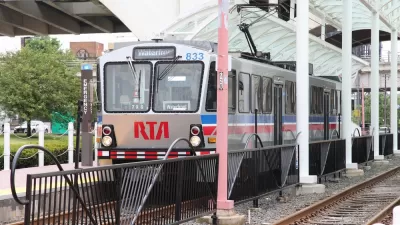Most North American cities offer only basic public transit service, with limited coverage and frequency, modest speeds, unattractive waiting areas, poor land use integration, and few amenities. Such service is used primarily by people who lack alternatives. In such communities, riders tend to abandon public transit as soon as feasible.
Most North American cities offer only basic public transit service, with limited coverage and frequency, modest speeds, unattractive waiting areas, poor land use integration, and few amenities. Such service is used primarily by people who lack alternatives. In such communities, riders tend to abandon public transit as soon as feasible.
In cities with high quality public transit even affluent people often use alternative modes. In addition to travel shifted directly to transit, high quality transit tends to leverage additional vehicle travel reductions by stimulating compact, mixed, walkable development. As a result, residents of communities with high quality public transit tend to own fewer vehicles and drive less, and spend less on transportation, than they would in communities that offer only basic transit service.
High quality transit requires the following features:
· Covers a large portion of regional destinations, such as business districts, major sport and cultural facilities (arenas, theaters and conference centres), college and university campuses, and residential neighborhoods.
· Service is relatively frequent and relatively fast (a significant portion of service is grade separated and so avoids congestion).
· Waiting areas and vehicles are comfortable, safe, and easily accessible.
· Attractive stations that are well integrated into neighborhoods, creating transit oriented development (compact, mixed use development around stations).
· Affordable and convenient pricing.
· Support and encouragement features, including good walking and cycling conditions, and efficient parking management in station areas.
Overall, residents of communities with high quality public transit tend to own 10-30% fewer vehicles and drive 10-30% less than they would in more automobile-oriented communities, as indicated in the figure below.
TOD Impacts On Vehicle Ownership and Use (Ohland and Poticha 2006)

Residents of transit-oriented developments tend to own fewer vehicles, drive less and rely more on alternative modes than in more automobile-oriented communities. "Daily VMT" indicates average daily vehicle miles traveled per capita.
These reductions in vehicle ownership and use provide various types of consumer savings:
· Travelers shift from driving to public transit, reducing variable costs (fuel, vehicle wear-and-tear, parking fees and tolls).
· More accessible, compact and mixed development reduces driving distances, and allows more trips to be made by walking and cycling.
· Improving transportation options reduces the need to chauffeur non-drivers.
· With better transportation options, some households reduce their vehicle ownership, often avoiding the need for a second or third vehicle, and if transport options are very good, some households may give up vehicle ownership altogether.
· Reduced vehicle ownership reduces residential parking costs, which can provide additional household savings.
Of course, actual impacts vary depending on individual household's needs and preferences. Some may not change at all, while others will reduce their automobile use and expenditures more than average. People who are physically or economically disadvantaged are particularly likely to use alternative modes and take advantage of opportunities for financial savings, proving affordability and equity benefits. Because they spend less on transportation overall and have more opportunities to save even more if faced with a financial stress (such as fuel price spikes, a vehicle failure or reduced household income), households in more accessible, multi-modal neighborhoods also tend to have lower home foreclosure rates.
According to analysis described in our new study, Raise My Taxes, Please! Evaluating Household Savings From High Quality Public Transit Service, providing high quality public transit service typically requires about $268 in annual subsidies and $108 in additional fares per capita, but reduces vehicle, parking and road costs an average of $1,040 per capita. For an average household this works out to $775 annually in additional public transit expenses and $2,350 in vehicle, parking and roadway savings, or $1,575 in overall net savings, in addition to other benefits including congestion reductions, reduced traffic accidents, pollution emission reductions, improved mobility for non-drivers, and improved public fitness and health. Physically and economically disadvantaged people tend to enjoy particularly large savings and benefits since they rely on alternative modes and are price sensitive.
Transportation investments are not usually evaluated in this way. Conventional economic evaluation compares transit investments with just roadway costs; vehicle and parking costs are generally ignored, although roadway transport requires a vehicle and parking for each trip. Other benefits, such as improved mobility for non-drivers, reductions in sprawl-related costs, and improved public fitness and health are also ignored. As a result, conventional analysis underestimates the full savings and benefits of public transit service quality improvements.
Because it provides diverse benefits, creating high quality public transportation is a win-win solution: most people benefit overall, including those who currently rely on alternative modes, those who switch from driving to alternative modes in response, and those who continue to drive who enjoy reduced traffic and parking congestion, reduced accident risk, reduced need to chauffeur non-drivers, and various indirect savings and benefits.
Conventional public transit service is comparable to economy class airline travel; it transports people with minimal convenience, comfort or prestige. High quality public transit service is comparable to first class airline travel, which responds to affluent consumers' demands for convenience, comfort and respect. Airline travelers can choose the service quality they prefer: inexpensive basic service or more expensive higher quality service. Transit users do not usually have such options. To obtain higher quality service public transit users must convince public officials that service improvements are cost effective compared with other transport system investments, and convince citizens to support any required tax increases.
This is a timely issue. Current demographic and economic trends are increasing demand for alternative modes. Many transportation policies and planning practices that may have been justified in the past are not appropriate for the future. More comprehensive planning is needed to identify truly optimal transportation policies and projects.
When all impacts are considered, consumers have every reason to demand, Raise my taxes! to create high quality public transportation in their communities.

Planetizen Federal Action Tracker
A weekly monitor of how Trump’s orders and actions are impacting planners and planning in America.

Map: Where Senate Republicans Want to Sell Your Public Lands
For public land advocates, the Senate Republicans’ proposal to sell millions of acres of public land in the West is “the biggest fight of their careers.”

Restaurant Patios Were a Pandemic Win — Why Were They so Hard to Keep?
Social distancing requirements and changes in travel patterns prompted cities to pilot new uses for street and sidewalk space. Then it got complicated.

Platform Pilsner: Vancouver Transit Agency Releases... a Beer?
TransLink will receive a portion of every sale of the four-pack.

Toronto Weighs Cheaper Transit, Parking Hikes for Major Events
Special event rates would take effect during large festivals, sports games and concerts to ‘discourage driving, manage congestion and free up space for transit.”

Berlin to Consider Car-Free Zone Larger Than Manhattan
The area bound by the 22-mile Ringbahn would still allow 12 uses of a private automobile per year per person, and several other exemptions.
Urban Design for Planners 1: Software Tools
This six-course series explores essential urban design concepts using open source software and equips planners with the tools they need to participate fully in the urban design process.
Planning for Universal Design
Learn the tools for implementing Universal Design in planning regulations.
Heyer Gruel & Associates PA
JM Goldson LLC
Custer County Colorado
City of Camden Redevelopment Agency
City of Astoria
Transportation Research & Education Center (TREC) at Portland State University
Camden Redevelopment Agency
City of Claremont
Municipality of Princeton (NJ)






























